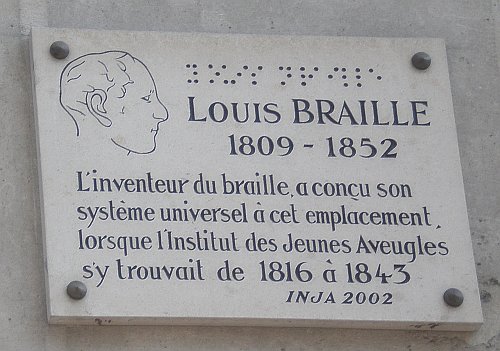Louis Braille
by Andrew Boyd
Today, injury sparks creativity. The University of Houston's College of Engineering presents this series about the machines that make our civilization run, and the people whose ingenuity created them.
Frenchman Louis Braille had his life upended when, at age three, he was injured while playing in the family workshop. The Brailles lived at the turn of the nineteenth century near Paris where Louis' father was a harness maker. Louis damaged an eye with a harness-making tool. It became infected, spread to both eyes, and ultimately left Louis blind.
But the injury wouldn't stop Louis or his family. At age ten, Louis gained entrance into the Royal Institute for Blind Youth in Paris — the first of its kind in Europe. The school had a handful of books with raised type, allowing students to read with their fingers. But distinguishing the many curved letters was slow. Most learning took place through lectures.
Shortly after Louis' arrival at the Royal Institute, Captain Charles Barbier of the French army approached the school's director with a new method of writing. The method, which used raised dots and dashes instead of letters, had been developed under orders from Napoleon. It allowed soldiers to exchange information at night without speaking.

The Institute's director and students were excited, especially the thirteen year old Louis. By age fifteen Louis had created his own alphabet. It used raised letters based on patterns of six dots instead of the twelve required with Barbier's method. Words could be written and read more quickly and without error. Louis continued to refine his system, extending it with, among other things, musical notation. We now know the system by the English pronunciation of Louis' last name: Bray-ul.
Broad acceptance wasn't immediate. But the method proved versatile, and in doing so found followers.
France officially recognized Braille as an approved system in the mid nineteenth century, and began promoting it throughout Europe. A world congress for the blind met in Paris in the late nineteenth century that in turn gave its blessing to Braille. In the mid twentieth century, the United Nations spearheaded efforts to adapt Braille to more than two-hundred languages.

Recognizing his lasting, international contribution to humanity, many nations struck coins in 2009 commemorating the two-hundredth anniversary of Louis' birth. Among the nations was the United States, minting a dollar coin bearing readable Braille.

And what of Louis Braille? Sadly, he contracted tuberculosis and died at the age of forty-three. But the life he lived was anything but sad. An accomplished organist and beloved teacher at the Royal Institute, he was content with life, seeing with a clarity others couldn't. "Yesterday was one of the greatest and most beautiful days of my life," he told a friend during his waning days. "God was pleased to hold before my eyes the dazzling splendors of eternal hope."

I'm Andy Boyd at the University of Houston, where we're interested in the way inventive minds work.
Louis Braille Bicentennial Silver Dollar. From the Web site of the U.S. Min.
The picture of the Braille type was taken from the flickr Web site https://www.flickr.com/photos/lissalou66/2997534298. The pictures of the Braille commemorative coin are from the U.S. Mint. The picture of the plaque recognizing Louis Braille is by Sarah Fishman Boyd; it can be found in Paris at the intersection of the Rue des Écoles and the Rue du Cardinal Lemoine, the home of the Royal Institute for Blind Youth from 1816 to 1843.
This episode was first aired on July 28, 2011.